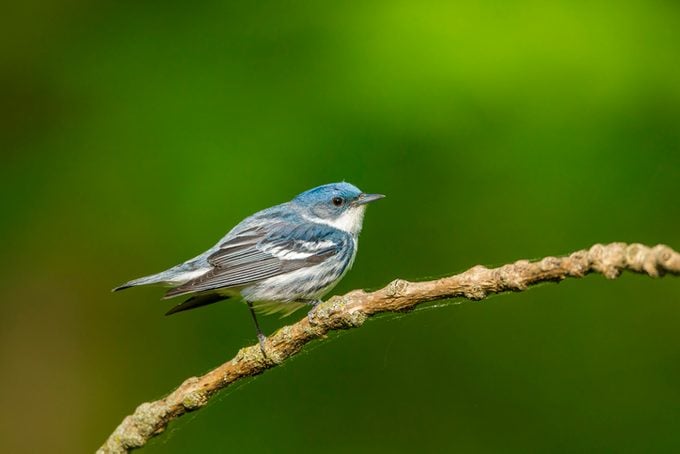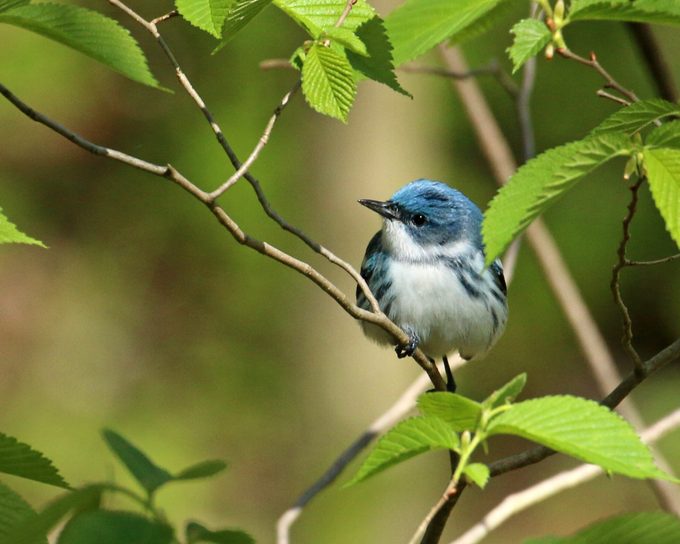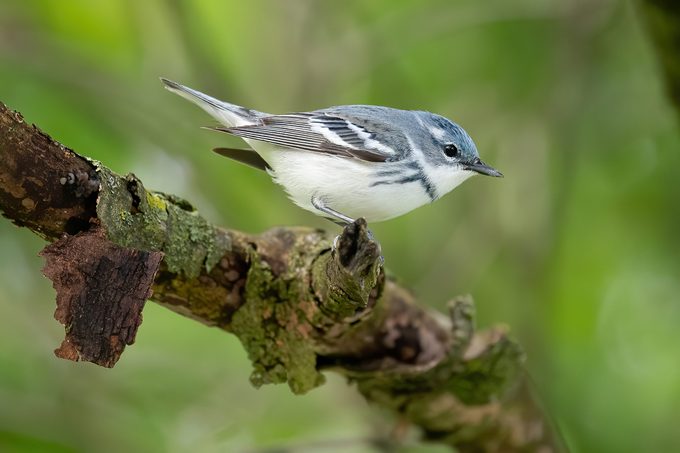How to Identify a Cerulean Warbler
Updated: Jun. 17, 2024
Learn what a cerulean warbler looks like, sounds like and eats. Plus find out why it can be tricky to track down this tiny blue bird.
On This Page
What Does a Cerulean Warbler Look Like?

Some birds like robins, goldfinches and cardinals are frequently sighted in backyards across America. Other bird species are much more uncommon, and a brief glimpse of them can thrill birders for life — and of these birds is the cerulean warbler.
While cerulean warblers are especially exciting because of the stunning blue feathers on the adult male’s head, back, and wings, seeing those blue feathers can prove a challenge. After they’ve migrated to their breeding grounds these warblers tend to stick to treetops, which means birders tend to only catch a glimpse of their white bellies. Females are duller than males, with upper plumage appearing greenish rather than blue and light yellow bellies.
Pamela Hunt, senior conservation biologist for New Hampshire Audubon, mentions the difficulty of seeing the feathers for which this warbler is named. “You hear them, and they’re way up in a tree somewhere,” she says. “You’re trying to find it, and you wait, and you wait, and eventually you see it fly and you see the white belly. At the right angle you can see the bluish-gray necklace across their throat, which is one of their cool diagnostic things.”
Cerulean Warbler Range and Habitat

This species winters in South America and passes through the eastern states during migration. They breed as far north as Wisconsin, Michigan and New York. Atypical visitors to the West, the places where it’s easiest to find them tend to be tall forests or river valleys. “They’re a deeper forest species, and they’ll not likely be found in a residential area,” Pamela says. “They like their hardwoods.”
In general, finding a cerulean warbler can be a challenge even for a dedicated birder. Pamela maintains that the places it’s easier to locate them tend to require some hiking and neck-craning. “It’s a ‘hop at the top of the trees’ species, but it’s hard to find, in general,” she says. “In certain places they’re easy to find, but they’re up in the mountains.”
Diet: What Do Cerulean Warblers Eat?

As is the case with most warblers, ceruleans dine mostly on insects, including caterpillars and moths, and won’t appear at backyard feeders.
Nesting Habits
Nests consist of three to five eggs and are constructed in tall deciduous hardwood trees in mature forests. Cerulean warblers raise one brood during each nesting season.
Numbers of this species are declining, so take extra care not to disturb them during nesting season.
Songs and Calls
Bird sounds courtesy of the Cornell Lab of Ornithology
Cerulean warblers give a buzzing, warbling song that rises in pitch as it ends. If you think you’ve heard a cerulean warbler, you might want track down the bird to make sure — where their breeding ranges overlap, it could been a black-throated blue warbler.
“The ones we have in New England make a song that is similar to the one the black-throated blue warbler makes,” Pamela says. “We’ve come to the conclusion in east-northern New England that you cannot conclusively say it’s a cerulean warbler unless you’ve seen it.”
About The Expert
Pamela Hunt has worked with New Hampshire Audubon for more than 20 years. She holds undergraduate and graduate degrees in biology and zoology, and she earned her PhD from Dartmouth College in 1995. In her role as senior biologist for avian conservation, Pamela works with governmental organizations in the state to coordinate bird research and monitoring efforts.
Sources
- Audubon Field Guide, “cerulean warbler“
- Cornell Lab of Ornithology, “cerulean warbler: life history“




















